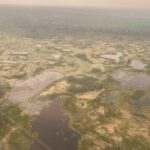Task 234
Aerosol Remote Sensing
Principal Investigator(s):
M. Petrenko
Sponsor(s):
C. Ichoku
Last Updated:
October 26, 2012 15:26:00
Description of Problem
The effects of atmospheric aerosols on the air quality, the hydrological cycle, and climate are still poorly understood. During the past decade, there have been increased efforts to employ satellite remote-sensing approaches in measuring aerosols in order to complement measurements from ground-based systems. However, because of the differences in the sensor measurement characteristics and algorithms used for aerosol retrievals, the products are often inconsistent, making it difficult to derive objective measures of aerosol amounts and properties. Therefore, it has become necessary to conduct integrated analysis of aerosol measurements acquired with different types of instrumentation, in order to narrow down the uncertainties that delay improvements in the knowledge of the different aerosol impacts. The purpose of this project is to provide an approach and a unified framework for inter-comparison and validation of aerosol measurements from different sensors and instruments, including ground-based, airborne, and spaceborne, obtained at different locations and time around the globe.
Scientific Objectives and Approach
A Multi-sensor Aerosol Products Sampling System (MAPSS) software and supporting database have been established as a consensus data framework for multi-sensor aerosol validation, inter-comparison, and joint-analysis. A simple web-based service was developed for rapid and efficient access to the database. In addition, a web portal was established to provide for a fast and convenient access to the database, as well as for a customized on-demand retrieval of the data from this database. As of the beginning of the reported phase of the project, MAPSS supported data derived from the AERONET (Aerosol Robotic Network), MODIS (Moderate-resolution Imaging Spectroradiometer), MISR (Multi-angle Imaging Spectroradiometer), and OMI (Ozone Monitoring Instrument) sensors.
Accomplishments
During the reporting period of March 1, 2010 – February 28, 2011, the MAPSS project has been expanded to include aerosol measurements from POLDER (POLarization and Directionality of the Earth’s Reflectances) and CALIOP (Cloud-Aerosol Lidar with Orthogonal Polarization) spaceborne sensors. Unique aerosol properties retrieved by these sensors, including polarization and vertical distribution, complement the AERONET, MODIS, MISR, and OMI measurements already supported by MAPSS. In addition, AERONET inversion and deconvolution products were incorporated into the MAPSS system, which had only the traditional aerosol optical depth products before the current reporting period. In this way, MAPSS currently provides one of the most comprehensive and accessible integrated data sets of aerosol measurements.
In addition to adding AERONET products, and POLDER and CALIPSO datasets, we continued improving the WEB interface for interactive plotting and retrieval of MAPSS data. An initial version of WEB MAPSS was first released to a select group of scientists, and based on their recommendations and our own rigorous tests, WEB MAPSS was further refined and released to a broader community of users.
To assess capabilities of the developed system as well as to introduce the system to the aerosol research community, we have used MAPSS to perform a series of preliminary multi-sensor aerosol studies. The studies showed that MAPSS can be effectively used to conduct integrated analysis of aerosol measurements acquired with different types of instrumentation, in order to narrow down the uncertainties that delay improvements in the knowledge of the different aerosol impacts. The results of these studies were reported at several international conferences, including The 9th International AeroCom 2010 workshop in Oxford, UK, The A-Train symposium in New Orleans, USA, and 2010 AGU Fall Meeting in San-Francisco, USA.






